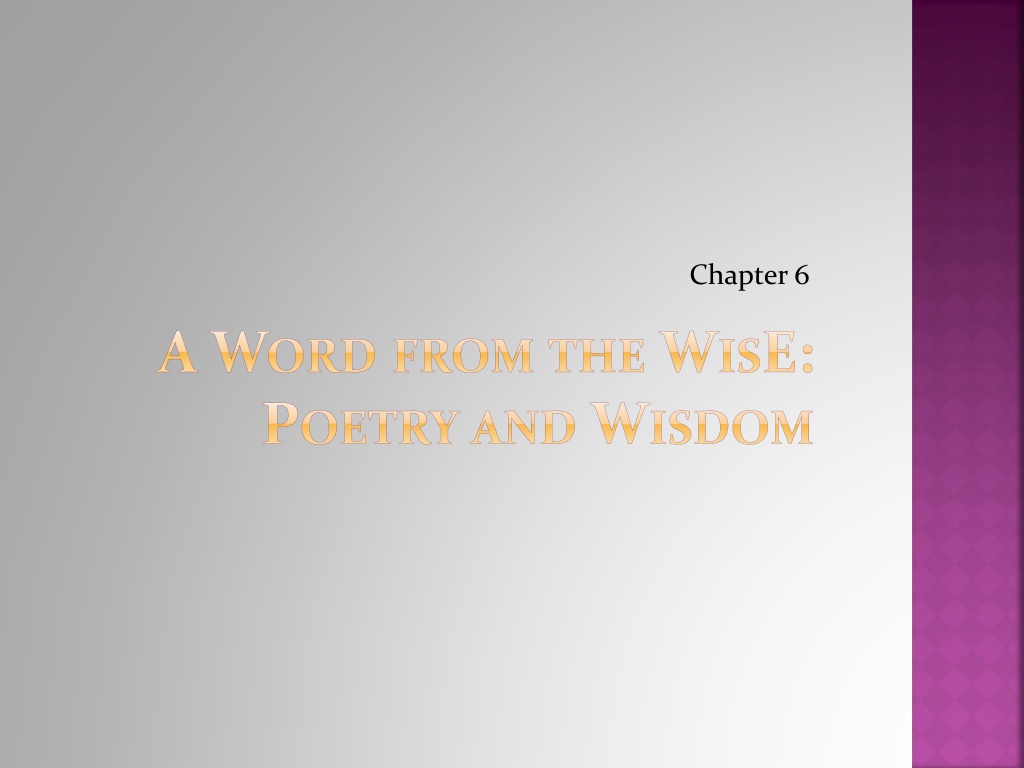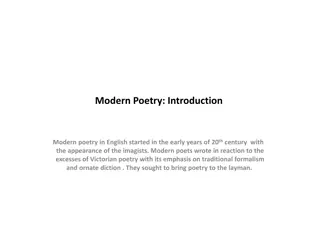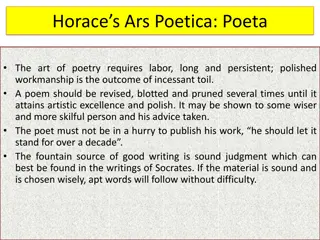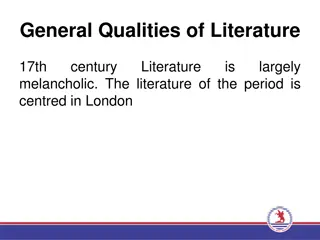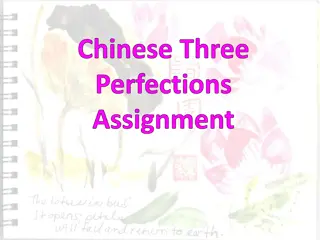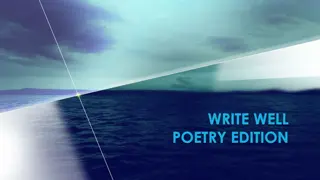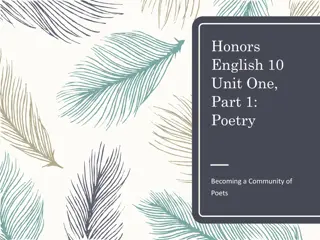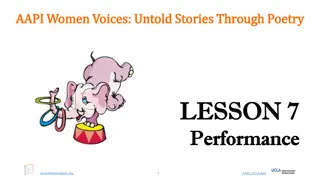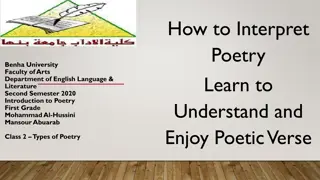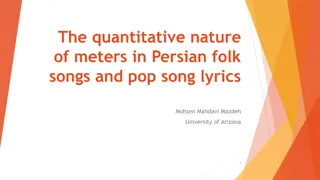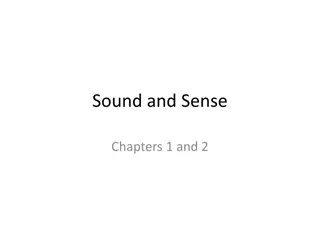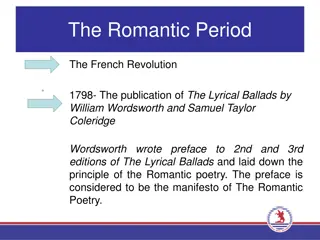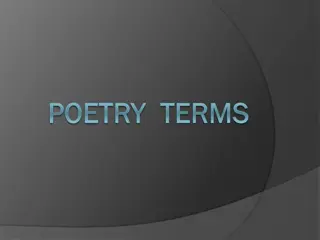Biblical Poetry: Nature and Characteristics
Poetry in the Bible is rich in imagery, using parallelism and concise language to convey deep meaning. This form of writing allows readers to engage with the text on various sensory levels, enhancing the overall interpretative experience. In the New Testament, the tradition of biblical poetry continues with authors drawing from Old Testament precedents, employing similar structural and stylistic devices. By exploring the poetic elements within the sacred texts, readers can gain fresh insights into theological discourses and narratives, illuminating the profound beauty and depth of biblical wisdom literature.
Download Presentation

Please find below an Image/Link to download the presentation.
The content on the website is provided AS IS for your information and personal use only. It may not be sold, licensed, or shared on other websites without obtaining consent from the author.If you encounter any issues during the download, it is possible that the publisher has removed the file from their server.
You are allowed to download the files provided on this website for personal or commercial use, subject to the condition that they are used lawfully. All files are the property of their respective owners.
The content on the website is provided AS IS for your information and personal use only. It may not be sold, licensed, or shared on other websites without obtaining consent from the author.
E N D
Presentation Transcript
Chapter 6 A WORD FROM THE WISE: POETRY AND WISDOM
CHAPTER OUTLINE The Nature and Characteristics of Biblical Poetry Poetry in the New Testament Structural Devices in Biblical Poetry Stylistic Devices in Biblical Poetry Wisdom Literature Sample Exegesis: The Book of Job
THE NATURE AND CHARACTERISTICS OF BIBLICAL POETRY Poetry is built around individual lines, which commonly feature the heightened use of imagery and figurative speech. Parallelism: The practice of using similar language of approximately the same number of words and length, and containing a corresponding thought, phrase or idea over succeeding lines. Similar Parallelism: provides closeness of thought and expression over parallel lines. Antithetic Parallelism: displays a contrast between two parallel lines. Progressive Parallelism: a succeeding line (or lines) supplements and/or completes the first line.
THE NATURE AND CHARACTERISTICS OF BIBLICAL POETRY Terseness Poets have a way of stating their thoughts so concisely that the result is a polished and succinct presentation free of unnecessary details. Concreteness Poetry allows the reader to see, taste, touch, smell, or hear the matters, which the poet portrays (p. 279, citing Michael Travers). Imagery By using an image, a poet portrays reality or expresses it in more concrete terms that demand the interpreter s careful attention and interaction. Imagery is a concise way of writing, because an image conveys not only information but also evokes an emotional response (p. 281, citing Tremper Longman).
POETRY IN THE NEW TESTAMENT The New Testament authors were all Jewish by background. When it came to poetry, therefore, they would likely think in terms of Old Testament precedents. For this reason the various parallel structures we have already noted can be encountered in the New Testament, whether (1) similar, (2) antithetic, or (3) progressive. Poetry may also be seen in the psalmic praises clustered around the nativity (Luke 1:47 55, 67 79), in many of the sayings of the New Testament (1 Tim. 3:16), and in its hymns and songs (Luke 2:14; Rev. 11:15; 15:3). Some passages are recorded as poetry in the New Testament (e.g., Phil. 2:5 11).
POETRY IN THE NEW TESTAMENT New Testament poetry likewise features terseness and concreteness. Imagery may be found throughout the pages of the New Testament, especially in the sayings of Jesus. By appreciating the poetic nature of relevant New Testament passages, the interpreter gains a new perspective. Even theological discourses become alive with new dramatic dimensions of structure, sight, sound, and stylistic sensitivity. John 1:1 18
STRUCTURAL DEVICES IN BIBLICAL POETRY Building Blocks Poetic structure begins with the individual line known as a stitch, verset, or colon. Structural Indicators Bookending The technique of returning at the end of a unit to a theme, subject, or word(s) mentioned at the beginning of that section. Stitching The author s practice of linking successive units or subunits of a poem by means of repeating a word, phrase, or idea. Chiastic Structure In chiastic structure, the second half of a composition takes up the same words, themes, or motifs as in the first half, but in reverse order. Bi-fid Structure The poet s structuring of his material in two parts, each answering to the other in similar or corresponding fashion and in the same basic order.
STYLISTIC DEVICES IN BIBLICAL POETRY Rhyme Rhythm Synonyms Unusual word order Allusion Ellipsis Fixed word pairs
GUIDELINES FOR INTERPRETING BIBLICAL POETRY Note the author s use of parallelism in accordance with the type employed. In psalms and extended poetic pieces, read the entire passage. Look for logical and formal structural devices. Learn to appreciate the author s use of imagery and figures of speech. Look for the author s unifying theme and consider carefully the flow of thought throughout the piece. Using sound exegetical procedures relative to poetic medium, make proper application to the contemporary situation. Consider the impact of the author s emphases to the spiritual life of the reader or hearer. 1. 2. 3. 4. 5. 6.
TYPES OF FIGURES OF SPEECH IN THE BIBLE Anthropomorphism Anthropomorphism is the ascription of human characteristics to God. Psalm 34:15 16 Euphemism Euphemism is the substitution of a less offensive term for an offensive one. 1 Kings 18:27 Hypocatastasis Hypocatastasis is a device in which the comparison is implied by direct naming. Nahum 2 Image Image is a word picture that makes an abstract idea concrete and reified. Revelation
TYPES OF FIGURES OF SPEECH IN THE BIBLE Metaphor Metaphor is the imaginative identification of two distinct objects or ideas. Psalm 84:11 Metonymy Metonymy is the substitution of one word for another. Psalm 45:6
SAMPLE EXEGESIS: PSALM 18 History Literature Theology
GUIDELINES FOR INTERPRETING FIGURES OF SPEECH IN THE BIBLE Take the literal meaning of statements of comparison unless there are compelling reasons to interpret them figuratively. Interpret each of the terms of the figure of speech (vehicle and tenor) before attempting to interpret what is intended by their figurative association. Pay due attention to connotations, as well as denotations, of the terms involved in the figure of speech. 1. 2. 3.
GUIDELINES FOR INTERPRETING FIGURES OF SPEECH IN THE BIBLE Read the figure of speech carefully for all of its import; do not skim read figures of speech in the Bible. In cases where an explanatory propositional statement follows a figure of speech, interpret it in the light of the propositional statement. Pay careful attention to contexts immediate and far, linguistic and historical in the interpretation of figures of speech. 4. 5. 6.
WISDOM LITERATURE The Nature of Wisdom Hokma and sophia Biblical wisdom sought in the first place, to provide guidance for living by propounding rules of moral order and, in the second place, to explore the meaning of life though reflection, speculation, and debate (p. 308, citing R. B. Y. Scott). The fear of the Lord as the beginning and goal of wisdom. Wisdom literature employs many different literary techniques.
WISDOM LITERATURE Proverbs Proverbs are short memorable statements of the true state of things as perceived and learned by human observations over extended periods of experience. In terms of the biblical Book of Proverbs, this refers to an apophthegm (a short, witty, and instructive saying) that has currency among those who fear the Lord.
WISDOM LITERATURE Select Types of Proverbs Descriptive proverbs Prescriptive proverbs Comparative proverbs Contrastive proverbs Conditional proverbs Declarative proverbs Instructional proverbs Numerical proverbs
WISDOM LITERATURE Ecclesiastes Written for the most part as poetry, Ecclesiastes contains the usual features of poetry such as various types of parallelism as well as terseness, concreteness, figures of speech, and abundant imagery. An unusual feature of Ecclesiastes is the author s double approach in searching for ultimate reality. Utilizing these poetic devices, The writer of Ecclesiastes has set for himself the task of making us feel the emptiness of life under the sun and the attractiveness of a God-filled life that leads to contentment with one s earthly lot (p. 319, citing Ryken). Utilizes repetition, such as under the sun.
WISDOM LITERATURE Job Job is written in poetry. Job is concerned with the sufficiency of God. Can he be trusted for every situation in life? Job is chiefly an example of disputation literature: Specifically, we hear the lengthy disputation speeches in which the speakers debate the cause of Job s suffering (p. 320, citing Klein, Blomberg, and Hubbard). Job includes psalmic materials, proverbs, satire, rhetorical questions, and widespread imagery. Yet, Job is also a story with a setting, plot, and characterization.
WISDOM LITERATURE Wisdom Elsewhere in the Old Testament Blessings of the patriarchs Historical books Prophetic books Wisdom Psalms Declarative Hortatory Reflective
WISDOM LITERATURE Wisdom in the New Testament Jesus as wisdom teacher par excellence Wisdom literature in teachings, parables, aphorisms of the epistles, especially James
SAMPLE EXEGESIS: THE BOOK OF JOB Author s basic purpose and central themes Pain and suffering Problem of evil Issues of justice and injustice Limitations of human wisdom Overall message The sovereign God is sufficient for all of life s circumstances.
SAMPLE EXEGESIS History The story is set in the patriarchal period. Geographically, the action takes place in the land of Uz, best associated with the northern Arabian Peninsula and the land of Edom. Literature Plot Denouement Resolution Characterization
SAMPLE EXEGESIS Basic lesson The wise person will surrender to the sovereign, holy, and wise Lord of the universe and find him sufficient for all of life s needs. Theology If we see things from God s point of view and put our trust in him, we will find him sufficient in all of life s trials.
GUIDELINES FOR INTERPRETING WISDOM LITERATURE Determine the central purpose of any wisdom piece. In Proverbs, note the type involved and the specific advice for godly living it is teaching. Evaluate the general maxims of Proverbs in the light of the proverb s ancient setting as well as in comparison with other scriptural teachings. Remember that proverbs are designed to be general guidelines and are not always applicable to every situation and circumstance. Where instruction is the proverb s chief goal, take seriously the truths and moral standards it is teaching. 1. 2. 3. 4. 5.
GUIDELINES FOR INTERPRETING WISDOM LITERATURE When interacting with Ecclesiastes, the interpreter should take careful note of both the positive and negative teachings of the book, balancing each in the light of the book s central purpose. In Job, the interpreter must come to grips with the central message of the book and evaluate the contribution of each part to the book s ultimate purpose. In Job, the interpreter should be careful to apply the rules of interpretation relative to storytelling such as setting, plot, and characterization. He should seek to determine what lessons are to be learned form the standpoint of each portion in the dialogue. 6. 7. 8.
GUIDELINES FOR INTERPRETING WISDOM LITERATURE The interpreter should be alert to occurrences of wisdom throughout the pages of the Bible. Especially to be noted are the teachings of Jesus. One should pay close attention to the theological and moral truths embedded in his teaching as crucial for the development of Christian character and conduct. 10. In every wisdom piece of literature, determine the chief goal of the instruction. Be careful to evaluate it in the light of the total scriptural revelation in order that proper application of its truths and moral lessons may be applied properly to contemporary living. 9.
